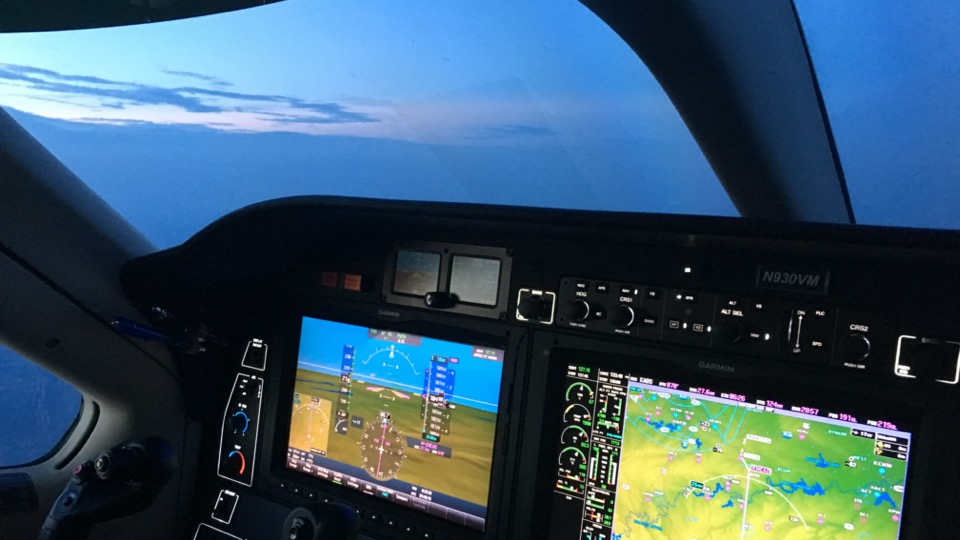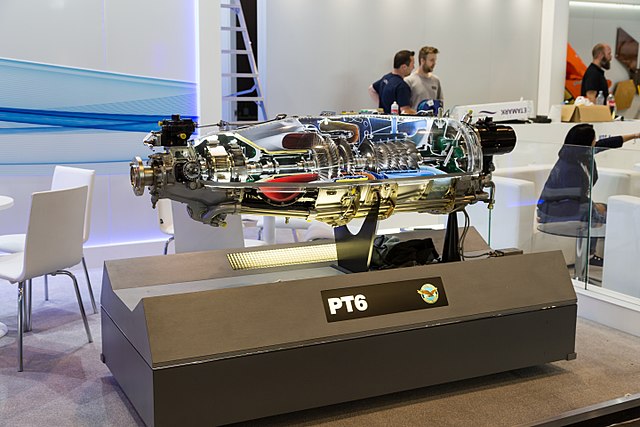
Turboprops engines seem to add a level of complexity to their gauges that can be intimidating and difficult to interpret to pilots unfamiliar with the nomenclature and operating principles of turboprop engines. Any unfamiliarity with turboprop operation is certainly reinforced by the dazzle of new terms, making familiarization even more difficult.
What are the engine operating terms for turboprops?
Torque (TQ in pound-feet) functions as the primary power selection tool, and Inter-Turbine Temperature (ITT) and NP (propeller RPM) are used to keep the engine inside normal operating limits. Gas Generator Speed (NG) is used to validate engine health during normal and abnormal operating conditions.
These terms might be easier than you think to understand, and later in the article we’ll cover the practical application in each phase of flight.
Defining Turboprop Operating Parameters
To start, defining each of the operating terms (and where they are measured) is the foundation for further understanding turboprop operation.
If you need a primer on this subject, first check out our article on the differences in piston and turboprop engines.
ITT – Inter-Turbine Temperature
Similar to the ITT used in turbofan engines, (See this article on N1 and N2 speeds for Turbofan details) ITT measures the temperature between the compressor stages and the turbine stages.
This is functionally the combustion gas temperature of the engine.
In the PT6A series of engines the temperature is measured downstream of the final compressor stage prior to gas flowing to the expansion turbine.
TQ – Torque
Torque is a measurement of the rotational force exerted on the gearbox by the engine’s turbine sections.
This can be measured in a variety of ways, but for the PT6A family of engines, this is a function of differential oil pressure between the first stage of the gearbox and the engine case.
NP – Propeller RPM
Turboprop engines drive propellers, therefore knowing the selected prop RPM is just as much a function of engine management and aircraft performance as any other parameter.
This is likely shown simply as RPM in many aircraft.
NG – Gas Generator Speed
NG references the rotation speed of the compressor section of the engine.
Generally, this is given as a percentage of a design maximum, because the difference between 20,000 RPM and 22,000 RPM is meaningless to a pilot operating across a wide range of altitudes and speeds.
It is possible to see rotational values greater than 100% (but uncommon) and is generally acceptable depending on the engine and operating condition.
Other “standard” engine parameters such as oil pressure, oil temperature, fuel flow and so on are also present for turboprops as with other aircraft.
While this video is a bit dated, it will also help serve as a good visualization of the turbine engine that can provide some context for the terms we are discussing here.
How do pilots manage turboprop engine parameters?
First, consider the basic principle of power generation – power is energy delivered at a rate. Turboprop power, just like with piston engine power, is measured in horsepower.
Horsepower breaks down into two basic components – torque x RPM.
So, to manage the power output of the engine, pilots have two basic tools – torque and RPM that can be manipulated.
For a turboprop engine, similar to a piston engine driving a constant speed propeller, there is a throttle lever and a propeller control lever.
Between these two controls the pilot sets the total power output of the engine.
Different aircraft will call for different prop RPMs and torque values, but generally, reducing propeller RPM will lead to a rise in torque and vice versa (assuming constant power output).
The operating limitations of a turboprop engine are driven then largely by the total horsepower output of the engine.
The pilot manages the torque and propeller outputs to maintain the horsepower with the specified acceptable limit for the current operating condition.
This as a basic operating principle is handy, but why then the additional parameters? What is the role of ITT and NG?
How do pilots use ITT on turbine engines?
Consider momentarily the leaning process for piston engines. Pilots reduce the fuel input to the engine as altitude increases to maintain an optimum combustion mixture within the engine, and this mixture is commonly monitored via the exhaust gas temperature.
For turboprops, ITT functions in a similar way.
As the aircraft climbs, fuel input is metered to maintain the correct combustion mixture in the engine.
At low altitudes, the engine can produce its maximum rated power without reaching the maximum ITT value.
During the climb, a “critical altitude” is reached where the engine no longer produces its maximum rated power at less than the maximum continuous ITT value.
Above this altitude, the pilot must reduce torque output to maintain the appropriate ITT value.
Below the critical altitude, the engine is considered “torque limited” meaning it produces the maximum rated power. Beyond the critical altitude, the engine becomes “ITT Limited” and no longer produces its maximum rated power.
As an example, the King Air 300 series aircraft with the PT6A-60A engine reaches its critical altitude on a standard day around 20,000 feet.

But even below the critical altitude most engines will have limitations on climb and cruise ITT values to maintain cooling and engine life. Pilots of turboprop aircraft must continually respect these limits, or risk engine damage.
Secondary to setting power ITT is also an indicator of engine health. As an engine ages, its critical altitude decreases.
Because of internal wear and degradation within the compressor and turbine sections, increasingly lean fuel mixtures are required to achieve rated power.
The amount of “ITT Margin” available in an engine is a design criterion that describes the engine’s expected service life, critical altitude, and to some extent, maximum power output.
How do pilots use torque on turbine engines?
Torque is used as the primary power selection indication for turboprop engines.
Typically, torque is given in foot-pounds, though some engines do use percent values.
Torque selection is analogous to manifold pressure in piston driven aircraft, as it is a measure of the work available to be transferred to the propeller.
Because torque is measured at the gearbox, it directly measures the energy being developed by the engine, from there, the specific gearbox design modifies this torque output to a useable RPM range for the propeller.
Below the critical altitude, pilots set torque directly using the throttle lever for the engine, above the critical altitude, the torque value is set referenced to the maximum allowable ITT.
The most critical, and arguably most difficult task for power selection, is takeoff.
Because of the mechanical characteristics of turbine engines, once the engine begins to accelerate, small changes in throttle position can result in large changes in power output.
Additionally, as the aircraft accelerates, ram air effects tend to increase the engine’s power output, similar to increasing RPM on a fixed pitch propeller with airspeed.
Careful power selection per the performance charts is required during the takeoff roll to both meet performance requirements and prevent over-torquing of the engine.
How do pilots use propeller RPM on turbine engines?
Propeller RPM is fundamentally a performance and noise parameter for turboprop operation. Pilots can directly manage prop RPM in most turboprop installations to achieve the desired the desired cruise performance and noise characteristics for the flight.
Additionally, ensuring proper RPM during takeoff is an indicator of proper power generation for the takeoff roll.
Cruise speeds are often delineated based on selected cruise RPM, where lower RPM selections generally will yield lower cruise speeds, but simultaneously lower fuel flows and better endurance.
For some of the newer digitally controlled and even FADEC controlled turboprop engines, prop RPM is trending toward a fixed or semi-fixed parameter, optimized by the manufacturer to achieve a balance of cruise speed, fuel flow, and cabin noise.
Cruise RPM settings are particular to specific aircraft types, but commonly, RPM is substantially lower than on piston powered aircraft; it is common for turboprops to drive propellers at 1500 RPM to 1900 RPM.
To understand propeller limitations, begin first with the upper limit.
Remember that rotational velocity is a function of the radius of the thing that is spinning. In the case of a propeller, to sufficiently convert engine power to thrust, large diameters are required (the Cessna Denali will have a 105-inch diameter propeller).
Large diameters result in transonic to even supersonic velocities at the propeller tips, which destroys efficiency and creates a tremendous amount of noise.
Aside from aerodynamic stresses associated with high tip speeds, structural loads, and the selectable range pitch range of the blades all drive the maximum allowed RPM.
Turboprops also often have minimum rotational speeds with the engine running.
This is a result of structural and vibrational characteristics of propellers, that result in a “reactionless mode” below a specific RPM. In the reactionless mode, a resonance develops between the blades and overpowers the balance weights and torque applied by the engine, resulting in large bending loads on the propeller.
During normal startup, shutdown and feathering, the propeller passes through this range sufficiently quickly that there are no issues, but the pilot needs to maintain sufficient power input to the propeller to keep the blades out of the reactionless mode.
Engine cooling and ITT values can also begin to become problematic at too low of an RPM.
How do pilots use NG on turbine engines?
For turboprops, the NG parameter is an indication of turbine health and the amount of energy present in the engine.
Remember that NG is the gas generator speed. NG references the rotation speed of the compressor section of the engine.
During starts and shutdowns, NG is a primary instrument to determine proper engine operation.
During engine starts, Ng is a primary governing parameter for the introduction of fuel as it directly measures the speed of the power turbine.
Introduce fuel at too low of an Ng value and a hot start is likely to be an issue.
Failure to reach a sufficient starting NG is also indicative of a failing starter-generator or even a failing electrical system.
During engine shutdown, proper decrease of the Ng value indicates proper fuel cutoff and spool down of the engine.
During abnormal operating conditions, such as failed starts, engine surges, or engine stalls, NG is the parameter in addition to ITT to inform the pilot of the health of the engine.
Unexpected decay or surging of NG is often one of the first signs of trouble for the engine.
Practical Application of Turbine Engine Instruments
To best describe the interactions between these parameters, a walk through of a generic flight profile may be helpful.
Also see below for our video on starting a TBM930 which will apply much of what is discussed in this article:
Engine Start
The pilot engages the starter and monitors NG to reach a minimum value prior to introduction of fuel.
After fuel is introduced, the pilot monitors ITT to avoid too high of a starting temperature, NG to verify the appropriate time to disconnect the starter and normal engine acceleration during the start, and propeller RPM to verify the prop reaches its minimum speed.
Preflight Run Up
Torque is now used by the pilot to set minimum values for some system tests, and propeller RPM is monitored to verify proper feathering of the propeller.
Takeoff
The pilot sets takeoff power using a torque value from the aircraft’s performance tables.
The pilot verifies that the ITT does not exceed any published limits and that the propeller RPM reaches the expected takeoff value.
Climb
The pilot modulates torque and propeller RPM to achieve the specified climb configuration, paying attention to torque rise if there is a reduction in propeller RPM as part of the climb checklist.
As the aircraft climbs above the critical altitude, the pilot is expecting the transition to being ITT limited, and reduces torque as necessary to remain below any climb power ITT limitation.
Cruise
Reaching the normal cruise altitude, another propeller RPM adjustment may be made depending on the preferred cruise profile.
If the cruise altitude is above the critical altitude, any changes to torque or RPM are closely monitored to avoid exceeding an ITT limit.
The pilot will monitor NG, ITT, and torque throughout the cruise segment for any abnormalities or shifts due to outside temperature, in addition any adjustments required because of climbs or descents are made, as necessary.
Descent
Reaching the descent phase of the flight, the torque is reduced to maintain the desired descent profile, and ITT is monitored to avoid temperature spikes descending through the critical altitude.
Propeller RPM may be adjusted if needed to maintain the descent profile desired by the pilot.
Approach
As the pilot configures the aircraft for landing, torque is used to maintain an appropriate airspeed for the approach.
At some point, typically around the final approach fix, or upon entering a visual pattern, the propeller RPM is selected to the highest available setting to provide maximum thrust in the even of a go-around or missed approach.
If the pilot does need to go-around for any reason, torque is used to carefully set power and ITT is monitored to verify it is within limits, similar to the takeoff roll.
Landing
After touchdown, the pilot reduces power to idle, and selects “beta” or reverse thrust as required, again monitoring torque, propeller RPM and ITT to avoid any unexpected engine behavior.
Shutdown
The pilot cuts off fuel from the engine and selects feather on the propeller. NG, propeller RPM, and ITT are all monitored by the pilot to verify a normal shutdown.
Conclusion
Turboprop engine parameters individually are not difficult to understand or use, but their novelty relative to turbofan engines or piston engines does present a unique challenge to properly understanding proper operation of the engine.
Torque functions as the primary power selection tool, while ITT and propeller RPM are used to keep the engine inside its normal operating limits. NG meanwhile is used to validate engine health during normal and abnormal operating conditions.



